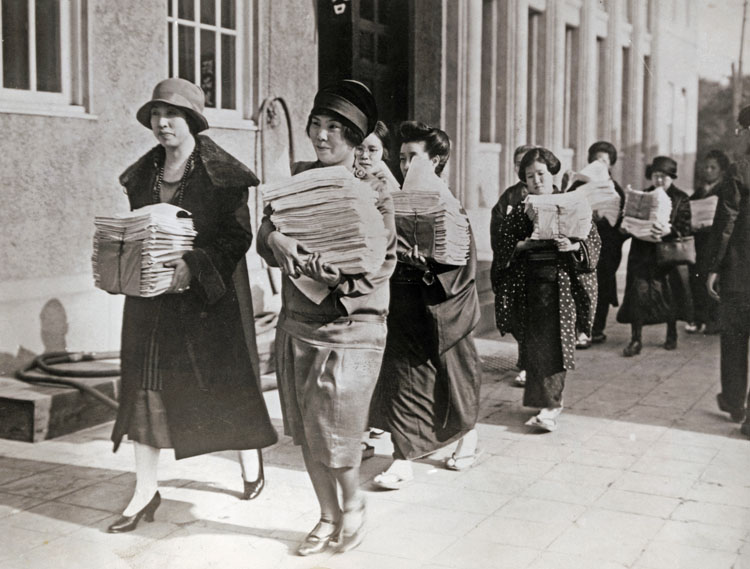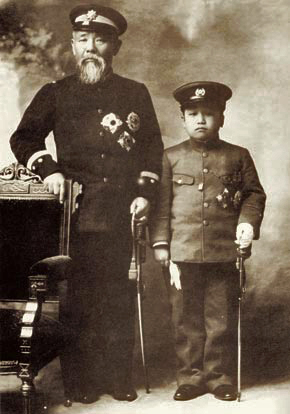Focusing on Imperial Japan
Focusing on Imperial Japan
“…Imperial Japan encompasses some of the most controversial topics that arise in discussions about Japan…”
As experienced teachers know, the opening minutes of a class set the intellectual and atmospheric tone for rest of the lesson. Scholars understand that the opening lines of a monograph shape how readers will interpret the entire text. It is no accident the first image to greet visitors when we first launched the About Japan website was the iconic image of Itō Hirobumi posing with Eumin, the child Crown Prince of Korea (which appears below). As you have experienced, clicking on the image introducing our focus on Imperial Japan brings you to this essay, which aims both to initiate a discussion of the teaching of Imperial Japan and to invite and perhaps provoke scholars and K-12 educators to be active participants in the newly forming About Japan community.
Out of all possible starting points for About Japan, we chose to focus on the theme of Imperial Japan, which we defined both to include Japanese imperialism as well as domestic Japan during the period when Japan was engaged in overseas imperialism in the late 19th and 20th centuries. Starting with this period serves several purposes. First, it is widely taught in English-speaking schools, even when little time is devoted to the teaching of Japan specifically. Broad issues of imperialism and the Pacific War are usually covered in this context, and the resources developed for this site can be used even when not formally teaching a course about Japan.
Second, About Japan aims to foster and provide a forum for an engaged community to discuss the most important issues related to Japanese history and culture, consider the multiple ways to teach about Japan, and provide the resources (or point community members towards the best resources) for teaching about Japan. As a community, the site also aims to break down many of the barriers that often exist among its members in the real world of both K-12 schools and universities, and thus serve the mutual interests of both communities—to promote intelligent dialogue, scholarship and teaching about the subject.
Third, Imperial Japan is a complex period in which Japan both influenced and was influenced by global cultural, political and technological developments. Unfortunately, it is also a period that is too often oversimplified, frequently devolving into rigid dichotomies such as “Westernization” versus “Traditionalism” or good vs. evil. That said, Imperial Japan encompasses some of the most controversial topics that arise in discussions about Japan, and we hope About Japan serves as a resource for informed and nuanced discussions about this controversial period. Last, we hoped to indicate that About Japan will not shy away from controversial issues, and, depending on the topic or time period, will always consider the larger regional and global contexts of Japanese developments.

Photograph from the 1920s of women bringing petitions to the Imperial diet demanding the right to vote.
Credit: Donated by Corbis-Bettmann
Initiating the process, we asked five professors specializing in Imperial Japan each to create a five-lesson unit about Imperial Japan, broadly defined. These units, reflecting the practical needs of many teachers, are divided into three social studies units, one unit in the visual and performing arts, and one unit in English and Language Arts. We then asked experienced K-12 teachers to revise the lessons, particularly the classroom activities, to maximize their effectiveness with their own students. We also selected and synthesized a selection of unit materials to create a series of lessons appropriate for a K-5 classroom. Though the units were devised as complete lessons, our intention is that they be viewed more as a series of suggestions for classroom activities, perhaps with modifications based on teaching styles and the student body.
We have developed technology to allow our editors to continue to edit lessons collaboratively now that the site is live. In addition, this technology allows any community member to submit teaching ideas related to the units, which the editors can then incorporate. We also encourage a less mediated discussion of the lesson plans, including comments regarding modifications of suggested activities or alternative resources that worked well with your own classes. Needless to say, we anticipate that content will grow and modify on a continuous basis.
Over time, we expect that our coverage of Japan, defined in terms of both theme and time period, will be wide-ranging. Using our collaborative publishing software, a select team of K-12 teachers and university professors will create five new units on a given theme three times per year. Planned upcoming units include Japan, 1945-2007; War and Occupation in 20th Century Japan; Panic Sites: Using Japan to teach about Terrorism, Political Violence, and Natural Disasters; and Teaching Pre-Modern Japan, among others. As with the Imperial Japan theme, we hope these will serve as a launch pad for further development and discussion by the About Japan community.

Itō Hirobumi and Crown Prince of Korea Euimin in 1907.
In fact, one of the key reasons for launching the site with the iconic image of Itō and the Crown Prince it is that it symbolizes, or at least hints at, many of the complexities of teaching about Japan, while offering a visual document that can be used as a practical resource in the K-12 classroom. For example, the image of Itō raises questions about the possibility of noble aspects to his intentions. The image also raises the issue not just of Japanese military domination, but cultural domination. The picture of the Crown Prince cannot be looked at without considering the role of collaboration on the part of elite members of Korean society. (These issues are highlighted in the K-5 lesson on heroes.) Last, by selecting this particular image, we hoped to underline that we are viewing the Imperial Japan theme not just in terms of imperialism, but domestic history as well, since Itō played a key role in domestic Japanese politics and democratization.
I am sure that the above paragraph raises a number of topics that many readers would like to take issue with – a central purpose of the essay section of the site. We created this space to serve as an area of reasoned, informed debate about Japan studies issues relevant to K-12 classroom teaching. We invite all community members to participate in these discussions, which we view more along the lines of a university seminar than a talk radio program in both tone and substance. Whether a discussion of the role of the “modern girl” in early 20th century Japan or the role and responsibility of Itō Hirobumi in Japanese imperialism, we look forward to the discussions that will follow.
Please find our current collection of Lesson Plans about Imperial Japan listed below:
Building "Greater" Japan, 1890-1905
The Sino-Japanese War, 1894-1895
The Russo-Japanese War, 1904-1905
Empire and Imperial Democracy, 1918-1932
Empire at All Costs, 1932-1945
The Fifteen Year War, 1931-1945
Shifting Perceptions: Japan and the World in the late 19th Century

